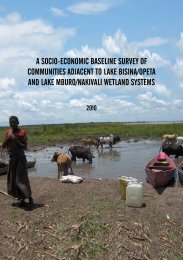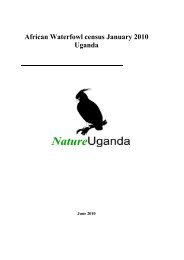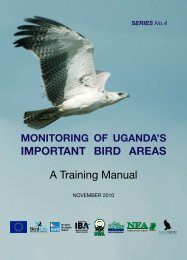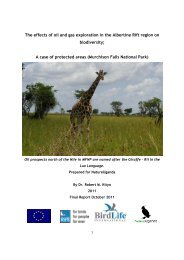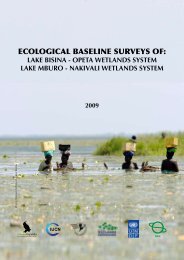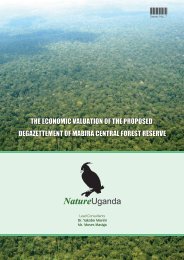Status and Trends 2009 - Nature Uganda
Status and Trends 2009 - Nature Uganda
Status and Trends 2009 - Nature Uganda
Create successful ePaper yourself
Turn your PDF publications into a flip-book with our unique Google optimized e-Paper software.
[A] <strong>Status</strong> <strong>and</strong> trends of conditions <strong>2009</strong><br />
Monitored IBAs in Ug<strong>and</strong>a <strong>and</strong> their location<br />
There are now 33 IBAs in Ug<strong>and</strong>a (Fig 2). Monitoring is<br />
being done with the help of the three main government<br />
departments in addition to <strong>Nature</strong>Ug<strong>and</strong>a’s monitoring<br />
programmes. UWA staff are monitoring 10 National Parks<br />
<strong>and</strong> 3 Wildlife Reserves, NFA staff are monitoring the 7 main<br />
Central Forest Reserves while WMD monitors wetl<strong>and</strong> IBAs/<br />
Ramsar sites. There are four Ramsar sites that are either<br />
wholly or partly in national parks. These sites are therefore<br />
jointly monitored by the two authorities.<br />
Summary of status of individual IBAs 2008 – <strong>2009</strong><br />
assessment<br />
The categories Favourable, Near Favourable, Un-favourable<br />
<strong>and</strong> Very Un-favourable describe IBA conditions signifying<br />
good, moderate fair <strong>and</strong> poor conditions respectively. When<br />
an IBA condition changes from one category to the next <strong>and</strong><br />
depending on the direction, it shows either improvement<br />
or decline <strong>and</strong> sometimes it maintains its status quo. In<br />
<strong>2009</strong>, 31 of the 33 IBAs were assessed. Table 1 shows the<br />
summaries with six IBAs in stable (good) conditions, seven<br />
had small declines, four had small improvements <strong>and</strong> two<br />
were in poor condition while 12 IBAs maintained moderate<br />
conditions when compared with 2008 assessments. Two<br />
IBAs (Lutoboka point <strong>and</strong> Lake Nakuwa) were not assessed<br />
in <strong>2009</strong>.<br />
<strong>Status</strong> categories of IBAs compared (2001 – <strong>2009</strong>)<br />
The IBAs generally seem to have been in good (Favourable)<br />
conditions than they are now. However, 2008 had 72%<br />
of the assessed IBAs in moderate conditions, while <strong>2009</strong><br />
presents 55% under this category. This is a good indication<br />
since the numbers of IBAs that are in favourable condition<br />
have gone up from 20% in 2008 to 32% in <strong>2009</strong>. This is<br />
however still less than the 55% in 2001. A ‘not so good’<br />
trend is also being seen in IBAs in poor conditions (Unfavourable)<br />
changing from 17% in 2001 to 8% in 2008 <strong>and</strong><br />
now 13% in <strong>2009</strong>. This means that a lot more pressures<br />
are coming up or appropriate interventions are not being<br />
made. Note that two IBAs, one wetl<strong>and</strong> <strong>and</strong> the other a<br />
Forest Reserve are not included in this year’s assessment. A<br />
lot more conservation interventions should target such IBAs<br />
with poor conditions for example Semliki Wildlife Reserve,<br />
Lutembe Bay <strong>and</strong> Nyamuriro Swamp while also not ignoring<br />
sites that are in moderate state because they too need<br />
some level of attention. Such IBAs include Murchison Falls<br />
NP, Kidepo Valley NP, Queen Elizabeth NP <strong>and</strong> others as<br />
shown in table 1 above. The comparisons of the categories<br />
between the years are as shown in fig 3 below.<br />
Percentage<br />
100%<br />
80%<br />
60%<br />
40%<br />
20%<br />
0%<br />
<strong>Status</strong> categories compared 2001 - <strong>2009</strong><br />
2001 2008 <strong>2009</strong><br />
Year<br />
favourable<br />
Near favourable<br />
Unfavourable<br />
Fig 3. Comparison of status categories 2001, 2008 <strong>and</strong> <strong>2009</strong><br />
<br />
Condition or state of IBAs<br />
(a) <strong>Status</strong> trends for all IBAs combined<br />
The year 2001 is being used as a baseline for which data is<br />
available. It should also be noted that although data for the 30<br />
IBAs were available, the 2008 analyses took care of only 22<br />
IBAs <strong>and</strong> an additional two that were added later onto the list,<br />
making a total of 24 IBAs whose data were analyzed. Now in<br />
<strong>2009</strong>, 31 of the total 33 IBAs have been included here in the<br />
analyses. The general trend has been maintained just above<br />
moderate conditions. Interestingly, the conditions showed<br />
general decline from 2001 to 2008 showing a drop from<br />
2.37±0.14 to 2.12±0.11 (Mean±SEM). This has however<br />
started to show an improvement of 2.19±0.12 (Mean±SEM).<br />
It should be noted that even with this improvement, the<br />
combined analyses does not reach the baseline level yet.<br />
Poor Moderate Good<br />
3<br />
2<br />
1<br />
0<br />
State trends of IBAs in <strong>2009</strong><br />
2000 2002 2004 2006 2008 2010<br />
Year<br />
Fig 4 State trends of all IBAs combined<br />
All IBAs<br />
(b) <strong>Status</strong> trends of IBAs in three management/habitat<br />
categories<br />
Sometimes it is not true that the general trend is the same<br />
across various habitat types <strong>and</strong> protected areas categories.<br />
Here attempts have been made to class the IBAs into three<br />
management categories namely National Parks <strong>and</strong> Wildlife<br />
Reserves (IUCN protection category II ), Forested IBAs<br />
(National protection status) <strong>and</strong> Wetl<strong>and</strong> IBAs (Ramsar sites/<br />
no protection). This has shown interesting results as below:<br />
(i) All the three categories (protected, forested <strong>and</strong> wetl<strong>and</strong>s)<br />
fall just above moderate conditions but with varying trends.<br />
This means that the different habitat types are being faced<br />
with varying level of threats <strong>and</strong> challenges; a trend which may<br />
reflect the level of commitments if they are to be improved.<br />
(ii) The condition of National Parks <strong>and</strong> Wildlife Reserves<br />
remained more or less similar for the 2001 to 2008 analyses<br />
with mean scores of 2.08±0.24 <strong>and</strong> 20.8±0.14 (Mean±SEM,<br />
n=13) <strong>and</strong> with a slight improvement in <strong>2009</strong> of 2.23±0.17<br />
(Mean±SEM, n=13). This therefore shows a positive trend<br />
when considered individually.<br />
(iii) The condition of forest Reserves has continued to have a<br />
steady decline through the years. Taking 2001 as the baseline,<br />
2008 <strong>and</strong> <strong>2009</strong> have all registered declines of mean scores<br />
of 2.63±0.18, 2.25±0.25 <strong>and</strong> 2.11±0.2 (Mean±SEM,<br />
n=9)respectively. This is however exhibiting a much gentler<br />
decline as compared to the wetl<strong>and</strong>s.



